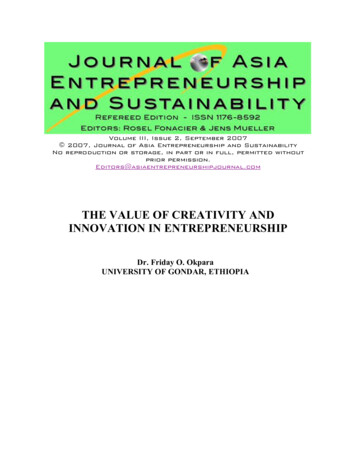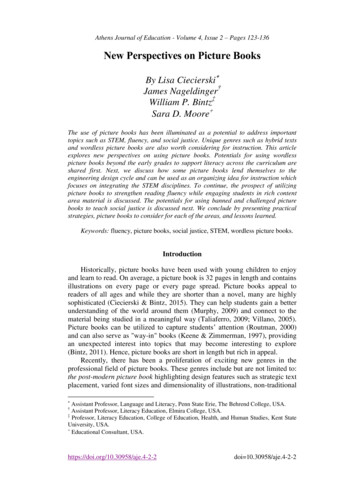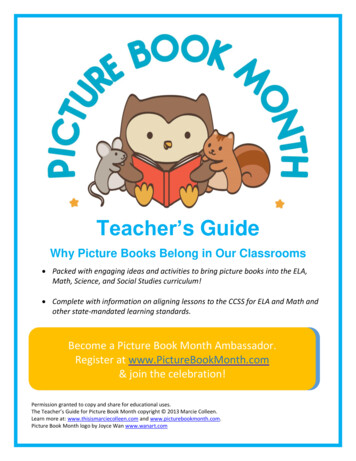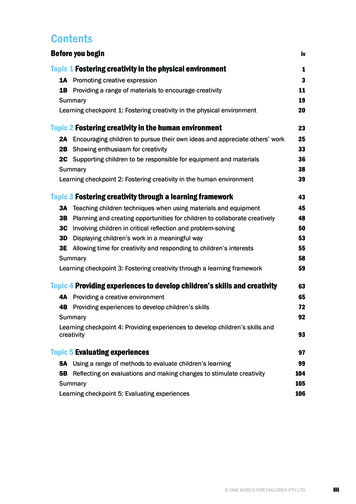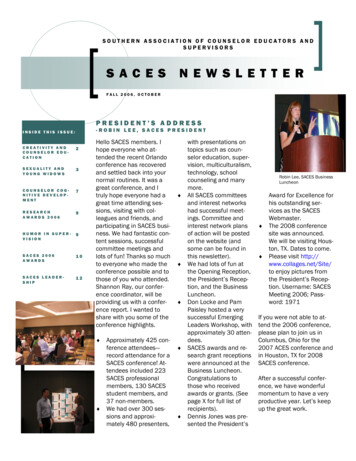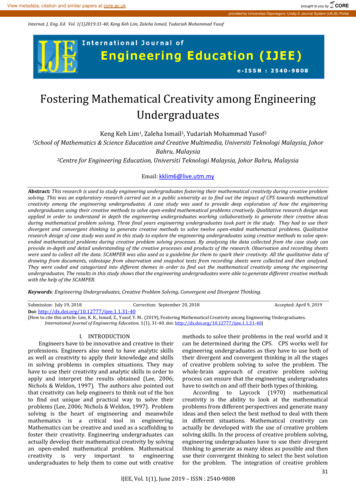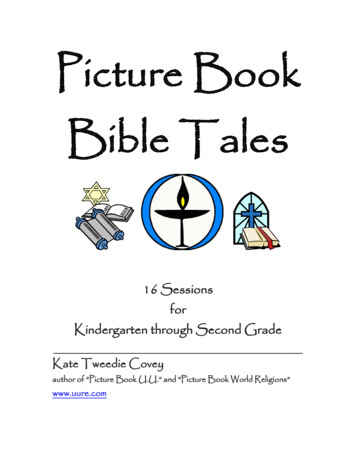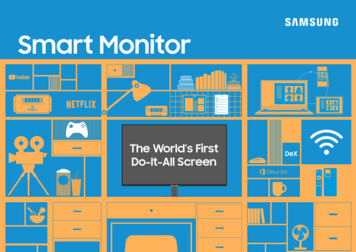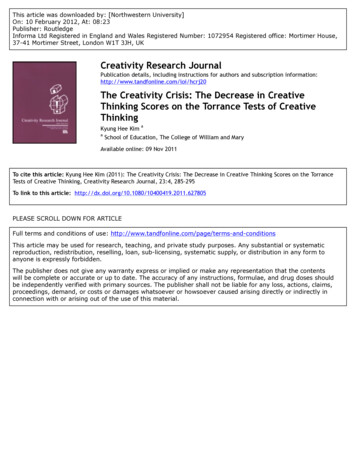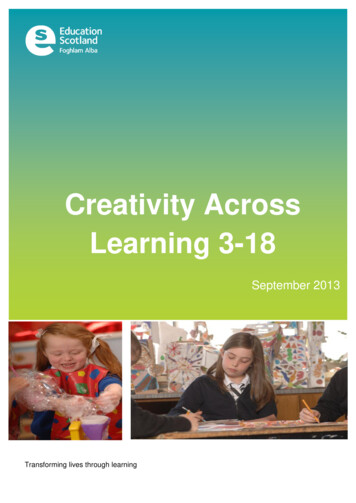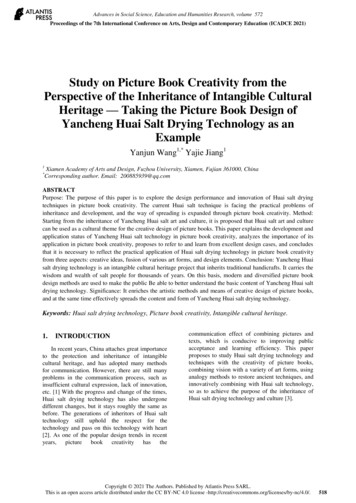
Transcription
Advances in Social Science, Education and Humanities Research, volume 572Proceedings of the 7th International Conference on Arts, Design and Contemporary Education (ICADCE 2021)Study on Picture Book Creativity from thePerspective of the Inheritance of Intangible CulturalHeritage — Taking the Picture Book Design ofYancheng Huai Salt Drying Technology as anExampleYanjun Wang1,* Yajie Jiang11Xiamen Academy of Arts and Design, Fuzhou University, Xiamen, Fujian 361000, ChinaCorresponding author. Email: 200885939@qq.com*ABSTRACTPurpose: The purpose of this paper is to explore the design performance and innovation of Huai salt dryingtechniques in picture book creativity. The current Huai salt technique is facing the practical problems ofinheritance and development, and the way of spreading is expanded through picture book creativity. Method:Starting from the inheritance of Yancheng Huai salt art and culture, it is proposed that Huai salt art and culturecan be used as a cultural theme for the creative design of picture books. This paper explains the development andapplication status of Yancheng Huai salt technology in picture book creativity, analyzes the importance of itsapplication in picture book creativity, proposes to refer to and learn from excellent design cases, and concludesthat it is necessary to reflect the practical application of Huai salt drying technology in picture book creativityfrom three aspects: creative ideas, fusion of various art forms, and design elements. Conclusion: Yancheng Huaisalt drying technology is an intangible cultural heritage project that inherits traditional handicrafts. It carries thewisdom and wealth of salt people for thousands of years. On this basis, modern and diversified picture bookdesign methods are used to make the public Be able to better understand the basic content of Yancheng Huai saltdrying technology. Significance: It enriches the artistic methods and means of creative design of picture books,and at the same time effectively spreads the content and form of Yancheng Huai salt drying technology.Keywords: Huai salt drying technology, Picture book creativity, Intangible cultural heritage.1.INTRODUCTIONIn recent years, China attaches great importanceto the protection and inheritance of intangiblecultural heritage, and has adopted many methodsfor communication. However, there are still manyproblems in the communication process, such asinsufficient cultural expression, lack of innovation,etc. [1] With the progress and change of the times,Huai salt drying technology has also undergonedifferent changes, but it stays roughly the same asbefore. The generations of inheritors of Huai salttechnology still uphold the respect for thetechnology and pass on this technology with heart[2]. As one of the popular design trends in recentyears, picture book creativity has thecommunication effect of combining pictures andtexts, which is conducive to improving publicacceptance and learning efficiency. This paperproposes to study Huai salt drying technology andtechniques with the creativity of picture books,combining vision with a variety of art forms, usinganalogy methods to restore ancient techniques, andinnovatively combining with Huai salt technology,so as to achieve the purpose of the inheritance ofHuai salt drying technology and culture [3].Copyright 2021 The Authors. Published by Atlantis Press SARL.This is an open access article distributed under the CC BY-NC 4.0 license 8
Advances in Social Science, Education and Humanities Research, volume 5722.THE DEVELOPMENT STATUSAND DESIGN IDEAS OF HUAISALT DRYING TECHNOLOGY INPICTURE BOOK CREATIVITY2.1 Development Status2.1.1more intuitively express the technology and content,add visual effects, tactile experience, and aestheticfeelings in the picture books, so that readers canhave a deeper experience. Therefore, it is necessaryto use Huai salt drying technology to do In-depthstudy of picture book design.2.1.2 Main Elements of Picture BookCreativityDevelopment ProcessAt present, there are relatively few picturebooks that mainly express the contents of Huai saltdrying technology in picture book creativity. Mostpicture book ideas on the market are designed forthe development and education of children, and thepicture book ideas of traditional techniques arealmost negligible. Through creative picture booksto convey Huai salt drying technology that canPicture book creativity is divided into fourmajor elements: graphics, text, composition andbook design. Graphics convey meaning, wordsexpress content, composition shows aesthetics, andbook design highlights creativity. The performanceof Huai salt drying technology needs to start withthese four elements in order to form an organicwhole. See "Figure 1".Elements of Picture Book vecompilingFigure 1 Creative elements of picture books (self-drawn).2.1.2.1 GraphicsIn picture book creativity, graphics are used toexplain to readers through creative expressionsaccording to certain textual intentions or expressthe image expression produced by the designerthrough thinking and subjective. It is a visualpresentation that is contagious to the theme and issymbolic. Graphical expression is undoubtedlyimportant to Huai salt drying technology, whichcan enhance the infectiousness of technical519
Advances in Social Science, Education and Humanities Research, volume 572expression and improve theunderstanding the technology.efficiencyof2.1.2.2 TextLike graphics, text also carries the function ofdescribing content. The difference is that thenarrative of the text is weak. Huai salt dryingtechnology is a technique, it is intangible. It’s farfrom enough to express through graphics alone, soa large amount of text is needed to support theexpression of skills to stimulate the imagination ofreaders2.1.2.3 CompositionThe composition can unify the text and graphicsinto the same picture, forming a complete andcoordinated picture, and increase the artistry. To alarge extent, the novelty of the composition candetermine the attractiveness of the picture. Thecomposition of the Huai salt drying technologymust follow all the principles of expressive skills,and arrange the pictures and texts reasonably toachieve the purpose of expressing skills.2.1.2.4 Book DesignBook design is the most coordinated part of theentire picture book design. It can arrange relativelyindependent text and illustrations into a book, sothat layout design, graphic arrangement, illustrationdepiction, cover design, opening and closingmethods, etc. can be integrated, thus forming acomplete creative picture book. Huai salt dryingtechnology also needs to start from the aspects ofgraphic layout, layout design, cover design,opening and closing methods, etc., to artisticallydesign the picture book to form an organic whole.2.1.3 Importance in Picture BookCreativityPicture book creativity is mainly to conveymeaning through images and words, and imagetransmission can be more intuitive, allowingreaders to more easily understand the main contentof the craft. Picture books use traditional handicraftutensils as materials to create picture books, anduse picture books as carriers to spread, protect, p. Adhering to cultural self-confidenceis an attempt to expand the subject matter of picturebook creation, and it is also an exploration tobroaden the channels of traditional culturaltransmission. As an intangible cultural heritage,Huai salt drying technology has a wide variety,diverse forms, and a long history. It is an importantpart of the traditional handicrafts of the Chinesenation [4].2.2 Design Ideas2.2.1 References and Excellent Cases ofHuai Salt Drying TechnologyThe picture book design of Huai salt dryingtechnology not only needs to rely on its owncultural heritage, but also needs to learn fromoutstanding works, and take the essence andremove the dross to carry out the creative design ofthe picture book. For example, Zhang Zhiqi’s book"Shandong Intangible Cultural Heritage Oral DanceHistory" shows the enthusiasm and excitement ofShandong Yangko Dance. As one of the mostdown-to-earth intangible cultural heritage, thewhole book is full of folk art and the joy of folk life.Each part will be clipped with colorful soft ricepaper to render this festive atmosphere. Thecolorful paper is used to compare the floatingribbons when dancing Yangko, which has asynesthetic effect and arouses strong resonanceamong readers. The strong colors and the coatedpaper on the normal inner pages are interspersedwith each other, which has a sense of rhythm andmelody, enriching the form of the inner pages andalso meeting the visual needs of readers. Thiscreative idea combines the rhythmic beauty ofmusic and gives the overall design soul. It is ahighlight of its design that readers can feel the richand joyful atmosphere of Shandong Yangko even ifthey are not watching the Yangko Dance throughthe feeling of materials and colors. In thepresentation of the book design, the designersshould also learn how Zhang Zhiqi controls thematerial and the color that gives people the feeling.Huai salt drying technology should also be as closeas possible to the materials and colors in theselection of materials and colors, and grasp thedegree of texture performance. In the design, it isalso necessary to pay attention to the integration ofmultiple art forms to enhance its effect [5].2.2.2 Design Practice of Huai Salt DryingTechnologyCreative picture book design has a certainfunctional value. With the continuous developmentof the modern technological era, the behavior ofreading pictures is also subtly affecting the thinking520
Advances in Social Science, Education and Humanities Research, volume 572and behavior of contemporary people [6]. Therefore,the spread of picture book forms is becoming moreand more important. Huai salt drying technologyprovides a new design language and material forthe field of picture book creative design. Today’spicture books are divided into two types: children’spicture books and adult picture books. For moretargeted research, the type of picture books in thisstudy is adult picture books [7]. In order to fullyexplore the creative research on picture books madeby Huai salt drying technology, and to enhance thevisual effects and aesthetic experience of picturebook creativity, it is necessary to deeply explore itsmethods in the field of picture book creativity. Thispaper mainly explores three aspects of creativeideas, multiple art forms and design elements, asshown in "Figure 2".Design practice of Huai salt drying technologyMultimedia artAction artPost-modern artMultiple art formsFitting the themeDivergent thinkingComprehending byanalogyCreative ideasCrystal salt particlesSalt-making toolsSalt-making vesselsDesign elementsFigure 2 Design and practice of drying technology of Huai salt (self-drawn).2.2.2.1 Creative IdeasBecause Huai salt drying technology isintangible, it needs to be transformed fromintangible to tangible in the design process. In thisprocess, the creative ideas that can diverge arerelatively wide. In general, creative ideas need tostart designing from the aspects of shape, color,material, typography, cover design, inner pagedesign letter case design, etc. In terms of creativethinking, the designer should follow the principle ofrestoring and carrying forward the ancienttechniques, and express the process of Huai saltdrying technology, the texture of Huai salt products,the tools of drying Huai salt, and their changes. Forexample, the authors' creative design for picturebooks uses the coastline of the place where Huaisalt is produced as the edge of the picture bookcover in the shape of the picture book cover design("Figure 3"). In terms of material selection, hardcardboard with fine texture is used. Dark blue, lightblue, gray blue and gray green are used to create agradual and superimposed effect, and at the sametime it is close to the concept of Huai salt by the sea.521
Advances in Social Science, Education and Humanities Research, volume 572("Figure 4") The technical part of the inner pagedesign uses blue line draft graphics as illustrations,which echoes the main color of the entire book. Thevertical typesetting of ancient books is used topresent the ancient feeling through the form ofthread installation, and some modern elements areadded. Through the combination of ancient andmodern feelings, a new form of expression of theinheritance of technology is created.Figure 3 Picture book cover design (self-drawn).Figure 4 Inside design (self-drawn).2.2.2.2 Various Art FormsAs a picture book of art, it is essentially theexpression and continuation of an action. Therefore,the form of expressing actions in picture books isalso indispensable. Digital media art has become anindispensable part of the modern era [8]. Designerscan borrow multimedia art to perform artificial522
Advances in Social Science, Education and Humanities Research, volume 572intelligence, augmented reality and othertechnologies to restore and reproduce the scenes ofdrying Huai salt, which provides a better methodfor the understanding of knowledge and eventransmission. Performance art is a new art form thatbreaks the traditional art. Designers can set upperformance art links when designing picture books,increase interaction with readers, make readersmore experience, and quickly understand the basiccontent of Huai salt drying technology. In thedesign, the authors draw the attention of readers bydesigning the small opening page. Readers can readthe small opening page together when turning to thepage to increase the interaction with the readers,thereby inspiring their interest in reading andachieving the spread of skills.2.2.2.3 Design ElementsThe final design elements in the Huai saltdrying technique are the salt particles themselvesand the constantly changing salt-making tools("Figure 5" and "Figure 6"). The whole body iscrystal white and the body is hard. Because Huaisalt is granular, readers need a certain sense ofsynesthesia during the touch process to satisfy theirsense of experience. Therefore, the tactileexperience should be paid attention to in the designof picture books. The authors borrowed Cubanpaper and other paper with uneven texture in thedesign. The authors use blue Cuban paper to adhereto the front and back of ordinary paper. The frontside is manually torn into the shape of a map ofJiangsu Province. Combining the design form ofdots, lines and surfaces, the white Cuban paper istorn into particles to simulate the passage of Huaisalt. The form of the coarse salt formed afterextraction is used to form a complete layout withdiscarded white strings. The illustration design inthe inner page should be integrated after referenceto the original literature, such as the salt-leachingtechnique in the "Picture of Boiling Wave" ("Figure7"), etc.Figure 5 Pan Pan (from Internet).523
Advances in Social Science, Education and Humanities Research, volume 572Figure 6 Drying board (self-photographed).Figure 7 Illustration design (self-drawn).3.CONCLUSIONIn the course of development, the skills, tools,and production processes handed down overthousands of years can become excellent paintingmaterials, turning it and its books into researchobjects, creating and recreating them, to form apicture book design, which can make thempropaganda and disseminate among a wide range ofreading groups, combine the two organically, andimprove the efficiency of communication. In simpleterms, a picture book is a combination of picturesand words to interpret a story with a plot. It is abook that expresses the emotion of the story and aspecial theme. In the process of designing picturebooks, the factors of art, aesthetics, fine arts,literature and other dimensions are combined.Designers need to fully understand all aspects of524
Advances in Social Science, Education and Humanities Research, volume 572Huai salt drying technology. Therefore, in theproduction process, designers have been putforward higher comprehensive requirements. Theyneed to pay attention to readers' aesthetic andreading needs, and pay attention to the developmenttrend and changing trend of the aesthetics of thetimes. The Z era emphasizes the uniqueness anddiversified expressions of aesthetic forms. Creativepicture books are a carrier for inheriting andcarrying forward intangible heritage techniques,and they can be appropriately used and displayedon ancient utensils, such as pots and pans. The useof artistic expression of works of art to promotetraditional culture and inherit traditional handicraftsadds to the fun of inheritance.[8] Yan Li, Application Research of TraditionalCraft in Handmade Book Art [J]. PackagingEngineering, 2017, 38(08): 76-79. (in Chinese)REFERENCES[1] Ren Yuan, Qin Huiyou, Research on theExperiential Binding Design of "YangzhouPaper-cut" [J]. West Leather, 2021, 43(02):41-42. (in Chinese)[2] Lu Tonggen, Huai Salt Elements inLianyungang Regional Culture [J]. JiangsuLocal Chronicles, 2019(04): 12-14. (inChinese)[3] Sun Jiakuan, Inheriting the Drying Skills Isthe Responsibility of the New Generation ofCraftsmen [J]. China Salt Industry, 2017(24):77-78. (in Chinese)[4] Zeng Zhu, Inheritance and Innovation ofTraditional Culture in the Teaching of Filmand Television Animation — TakingJingweier Culture Series Picture BookCreation Project as an Example [J]. HomeDrama, 2021(15): 169-170. (in Chinese)[5] Feng Beibei, Diversified Forms of BookBinding from Technology Beauty Perspective[J]. Packaging Engineering, 2017, 38(06):213-218. (in Chinese)[6] Wang Xiaodan, Research on Book DesignInvolved in Text Creation: Taking ZhuYingchun's Creative Book Design Practice asan Example [J/OL]. Science-Technology &Publication, 1-7 [2021-06-14]. (in Chinese)[7] Bin Youyan, Research on the Design of AdultPicture Books [D]. Kunming University ofScience and Technology, 2014. (in Chinese)525
2.1.2.4 Book Design Book design is the most coordinated part of the entire picture book design. It can arrange relatively independent text and illustrations into a book, so that layout design, graphic arrangement, illustration depiction, cover design, opening and closing methods, etc. can be integrated, thus forming a
